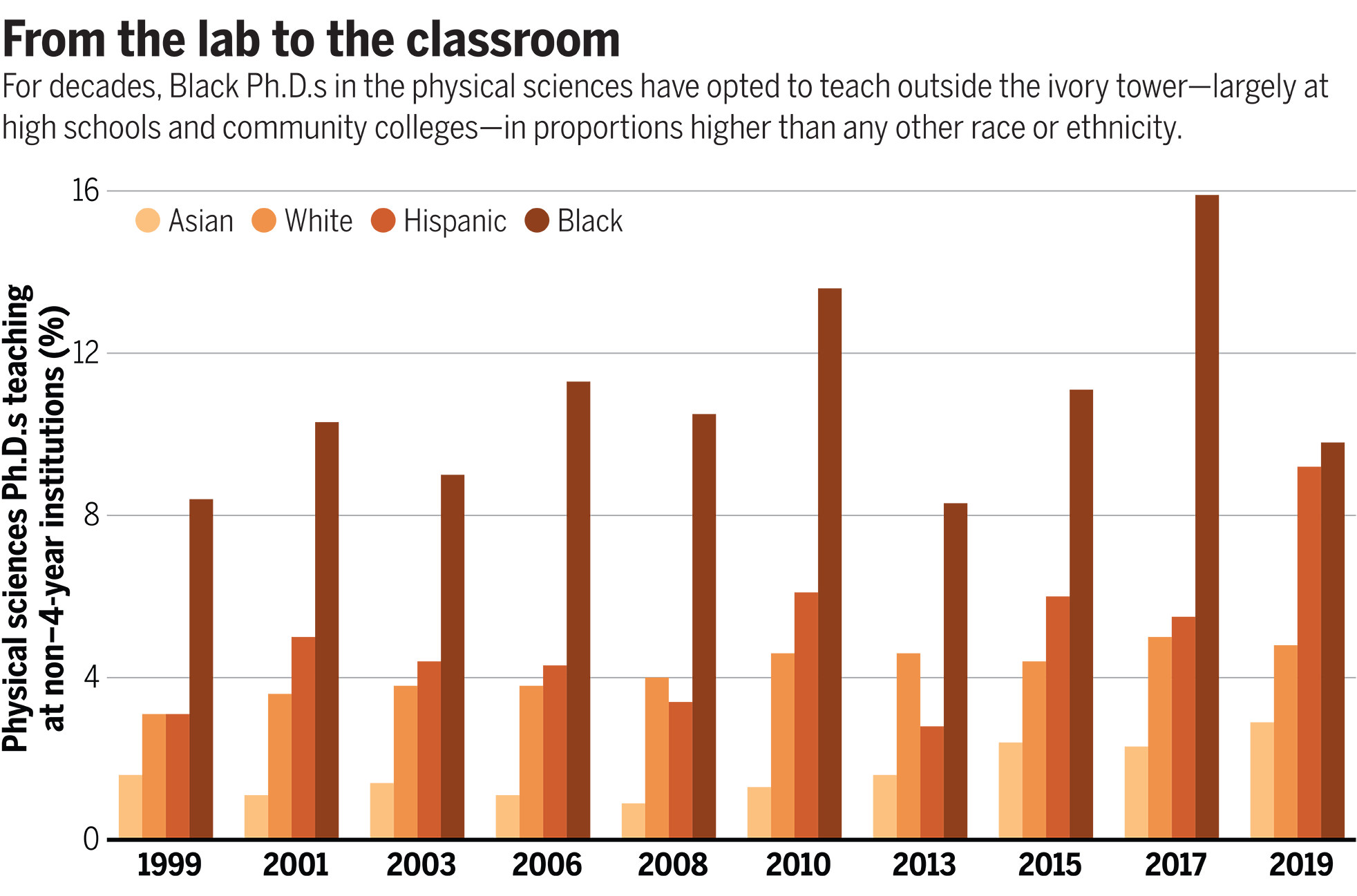A Surplus of Black PhDs Teaching Outside the Ivory Tower
For years, Maritza Tavarez-Brown couldn’t talk about the end of her astronomy career without tears. She’d wanted to be an astronomer since high school. But she struggled in her introductory physics classes at Yale University. At one point, she remembers, the department chair told her she should reconsider her major. Determined, she transferred to New York City’s Hunter College, earned bachelor’s and master’s degrees in physics, and completed a Ph.D. on the properties of dark matter halos at the University of Michigan, Ann Arbor. She was offered a postdoc at the University of California, Berkeley, the kind of prestigious apprenticeship that could catapult her to an academic faculty position.
She turned it down. She and her husband had just relocated with their 5-year-old daughter to Seattle, and they decided moving to the San Francisco Bay Area wouldn’t work for their family. That was more than 16 years ago, but Tavarez-Brown remembers it as if it were yesterday.
“I was devastated,” recalls Tavarez-Brown, who is of Afro-Cuban descent. “In Spanish, we have this saying, ‘You’re working so hard that you’re burning your eyelashes,’” she says. “I had done all this hard work, and now the thing that I was looking for … I can’t really do.” Instead, she took a position as a long-term substitute physics teacher at Forest Ridge School of the Sacred Heart, a middle and high school for girls in nearby Bellevue, Washington.
This story was originally published by Science as part of a special package about the barriers Black physicists face and potential models for change. Reprinted with permission from AAAS.
Today, “Dr. T,” as her students call her, is still at Forest Ridge, and she is part of a long but little-known tradition in U.S. science education: For decades, Black Ph.D. scientists have opted to teach outside the ivory tower in proportions higher than any other race or ethnicity. They are more than twice as likely as their non-Black peers to teach at 2-year colleges, high schools, or other pre-college institutions, according to an analysis of the National Science Foundation’s Survey of Doctorate Recipients. The disparity is present across a range of disciplines, but it has been especially pronounced in the physical sciences, where roughly one in 10 Black Ph.D. holders teaches outside of 4-year higher learning institutions — and where in some years Black Ph.D. holders have been more than three times as likely as the average to hold those jobs. These trends date back at least to 1999, the first year NSF published the relevant data.
Education experts puzzle over the causes of the disparity. But for their part, Tavarez-Brown and other Black Ph.D. physicists who have made the leap say they are finding fulfillment on a career path that many science graduates never consider traveling. For the students they teach, their career choices mean a chance to learn from trained scientists — and to see new role models in science.
The relative surplus of Black Ph.D. scientists teaching in high schools and 2-year colleges has slipped under the radar of many researchers. Ebony McGee, an associate professor of diversity and science, technology, engineering, and math education at Vanderbilt University, calls it “extremely surprising.” But she sees a possible explanation, pointing to evidence that many Black scientists and engineers flee the ivory tower because they find the environment constraining, marginalizing, and systemically racist. “What it sounds like to me is that the structures don’t allow them to see themselves as authentically in [university] faculty positions as they do in community college or high school positions.”
A close look at the NSF data suggests additional factors may be at work. The data indicate Black scientists who obtain doctorates are no less likely to teach at 4-year higher learning institutions than Ph.D. scientists from other racial and ethnic groups. (The NSF data don’t show what fraction of those faculty are at research-intensive as opposed to teaching-intensive schools.) Rather, for reasons that remain unclear, the surfeit of Black doctorates opting to teach at high schools and 2-year colleges appears to be offset primarily by a deficit of Black doctorate holders working in private industry.
Kimberly Griffin, a professor of higher education, student affairs, and international education policy at the University of Maryland, College Park, cautions that it would be a mistake to assume that Black Ph.D. holders who opt for pre-college and community college teaching careers are somehow settling. “This might be a very intentional choice,” Griffin says—“different than what they anticipated when they started [their Ph.D.], but still very intentional.”
Vanessa Cohen Gibbons’s decision to pursue a teaching career was very much intentional. She realized toward the end of her Ph.D. that what she enjoyed more than crunching numbers and writing papers was talking to people. Both of her parents taught at community colleges, and she had an aunt and a cousin who taught at public schools. Plus, she had enjoyed the teaching she’d done as a graduate student — and she’d excelled at it, winning student teaching awards.
It wasn’t that she lacked the research credentials to pursue a university faculty position. Her dissertation was on the dynamics of merging black holes, an area that would soon become one of the hottest in physics, with the dramatic first detection of gravitational waves from such mergers. In the run-up to academic hiring season, her adviser had even helped arrange for her to give a series of symposia and public talks — which, she says, were “very well received.”
But Cohen Gibbons, who is Black, figured a high school teaching position would offer her a chance “to be much more than just somebody who’s delivering content” — to engage with students in areas such as social and emotional learning and social justice. So, just months before the academic hiring season began, she decided to apply exclusively for high school teaching jobs. Before long she had multiple offers. She accepted a position at the Garrison Forest School, a private, all-girls K-12 school in suburban Baltimore. (The high school teachers interviewed for this story all opted for private schools, noting, among other factors, that those jobs allowed them to bypass the time-consuming certification process many public schools require.)
Cohen Gibbons’s realization, years into her graduate studies, that an academic research career wasn’t for her is hardly unusual. Studies have repeatedly found that, in aggregate, students tend to lose interest in faculty positions over the course of their graduate careers. In a 2017 study that surveyed more than 850 U.S.-based Ph.D. students in physics, chemistry, engineering, computer science, and the life sciences, nearly one-third of students who entered their Ph.D. programs expressing an interest in academic research careers had cooled on the idea by the time they neared graduation. The drop-off appears to be especially steep for women from underrepresented racial and ethnic groups.

In focus group studies, these women are also more likely to credit “externally focused” values — such as a desire to mentor students or to solve health problems facing their communities — as motivating factors in their career choice. A study conducted by the American Institute of Physics similarly found that Black physics students were more likely than physics students of other ethnic groups to express a commitment to benefitting their community.
Griffin, who co-authored some of those studies, thinks those values — particularly a desire to give back through education — could help explain the disproportionate numbers of Black Ph.D. scientists opting for careers in K-12 and community college teaching. “I could see someone getting a [science] Ph.D. and using that as their pathway to fulfill this cultural commitment.”
Fana Mulu-Moore likely falls into that category. As a postdoctoral fellow studying solar physics at NASA’s Marshall Space Flight Center, she did a lot of outreach, speaking to and working with students at historically Black colleges and universities, or HBCUs, in the southeast. Those interactions felt meaningful, she says. Meanwhile, she’d begun to feel burnt out by research, and she found it isolating being one of just a few Black women in her field. So in 2013, when Mulu-Moore took a year off to care for her newborn child, she decided she would pursue teaching jobs. After a summer stint as a high school physics teacher, she landed at Aims Community College, a small school in Greeley, Colorado, about 1 hour’s drive north of Denver. In the spring of 2021, she was promoted from an adjunct position to become the school’s only full-time physics professor.
Mulu-Moore describes Aims as a small, nurturing community that reminds her of her own alma mater, Alabama A&M University, the HBCU where she earned both her bachelor’s degree and her Ph.D. Its student body, like those of many community colleges, is diverse — roughly 40 percent students of color, many of them first generation students. “It’s a great place to make an impact,” she says.
Teachers with Mulu-Moore’s credentials are a boon to community colleges and high schools. According to a 2005 report from the American Association of Community Colleges, only about one-quarter of the science faculty at 2-year colleges hold doctorate degrees. In high schools, most physics, chemistry, and earth science teachers lack even an undergraduate degree in the discipline they teach, let alone a doctorate. According to recent data from the American Institute of Physics, just 27 percent of high school physics teachers hold a degree in physics, and about 4 percent have doctorates.
Two decades ago, the paucity of teachers trained in the sciences so troubled U.S. educators that the National Research Council convened a committee to explore the feasibility of recruiting more Ph.D. scientists and mathematicians into secondary school teaching. Some high school administrators the committee interviewed speculated that Ph.D. scientists would be “overspecialized and overprepared for teaching secondary school students.” They also noted they could not match the pay Ph.D.s could earn outside the classroom. Still, the council concluded that if high schools could woo Ph.D. scientists into their classrooms — and provide them with the necessary pedagogical training — the rewards would be plentiful.
For Mark Hannum, a White physics teacher who serves as K-12 programs manager at the American Association of Physics Teachers and heads the science department at Thomas Jefferson High School for Science and Technology, an important advantage of having trained researchers in the classroom is that, unlike many other science teachers, they think of themselves as scientists. Hannum, who has bachelor’s and master’s degrees in physics, counts himself among that group. Having a teacher who identifies as a scientist can profoundly impact the way the students see science, Hannum says. It gives them a role model — and all the better, he says, if that role model is someone who can broaden students’ perceptions of who does science. To that end, he says, “having Black Ph.D.s working in schools is immensely valuable.”
Having a scientific background can also affect how the teachers approach their work, Hannum says. “I think that mindset has subtle ramifications that spill over in a lot of ways.” For example, trained scientists are typically better prepared to emphasize the scientific process over content memorization, he says, and they bring a keen understanding of what it means to produce knowledge through experimentation.
The prospect of bringing research know-how into the classroom appealed to Angela Meyer. After finishing a Ph.D. in astronomy at Georgia State University, Meyer — a biracial Black woman — took a tenure-track faculty position at Florida Gulf Coast University, where she expected to help develop a new earth and space sciences major and launch a new observatory. But those plans never panned out. After a conversation with a cousin-in-law who taught biology at a private high school, Meyer figured a private school setting might offer her the opportunities she sought.
Meyer wound up at Culver Academies, a private boarding high school in northern Indiana. The job allowed her to pursue science without the constant pressure to write grants and publish. She developed a new astronomy curriculum, and she explored the use of classroom observatories — small, remote telescopes designed for educational use that can be controlled through the internet. One such observatory she’s worked with, a network of telescopes maintained by the Harvard-Smithsonian Center for Astrophysics, can be used for classroom projects on finding and characterizing exoplanets. “It’s not research at the level I was doing,” Meyer says. But it allows her to combine her passion for working with students with her passion for working with data. “Those are my two great loves.”
As for Tavarez-Brown, she still feels twinges of regret. Once in a while, she’ll pull out her doctoral thesis and thumb through the pages, reminding herself of the work that went into it: the weeks in New Mexico learning to analyze data from the Very Large Array; the weeks in the Netherlands learning to reduce data from the Westerbork Synthesis Radio Telescope. For her, an academic research career was always the prize. It stings to know that the goal has likely drifted permanently out of her reach.
But, like so many other Ph.D. physicists who have followed similar paths, she is ultimately at peace with the way things worked out. “To have a girl come up to you and be like, ‘I never thought I was good in science,’ or ‘I never thought I can do this and like it,’ … honestly, you’re not gonna get that being an astronomer,” she says. “I know I’m making an impact — right here, right now, for the future generation.”
Ashley Smart is the associate director of the Knight Science Journalism Program at MIT, and a senior editor at Undark.
Except as provided by law, this material may not be further reproduced, distributed, transmitted, modified, adapted, performed, displayed, published, or sold in whole or in part, without prior written permission from the publisher.










